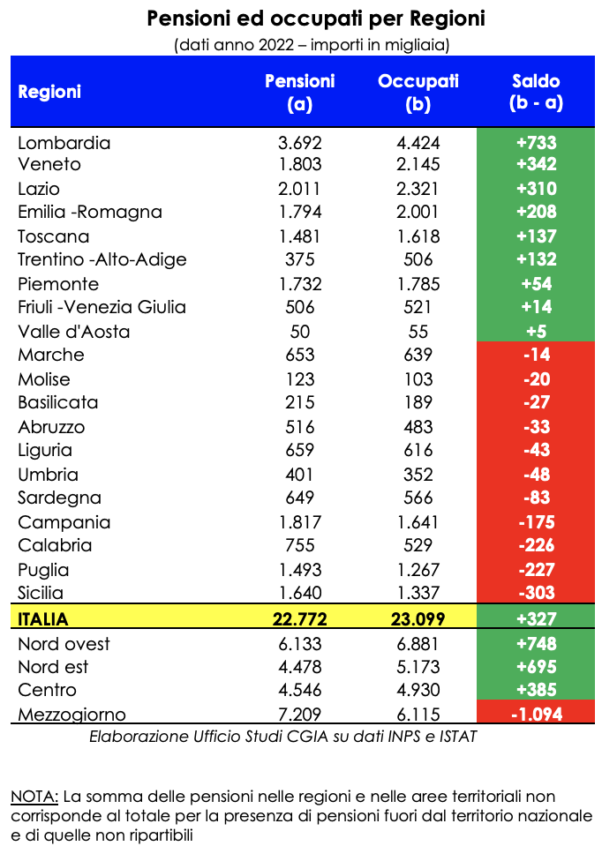If at a national level the ratio is now one to one, in the South, however, the overtaking has already occurred; we are talking about the comparison between the number of pensions paid and that of those employed. If in Italy the former is equal to 22.772.000 and the latter amounts to 23.099.000, in the regions of the South and the Islands the pensions paid to citizens are 7.209.000, while the employees are 6.115.000.

A worrying result which clearly demonstrates the effects caused in recent decades by three closely related phenomena: the birth rate decline, the aging of the population and the presence of irregular workers. The combination of these factors is progressively reducing the number of active taxpayers and, consequently, swelling the ranks of welfare recipients. This is what the CGIA Research Office says.
• How to rebalance the system?
There are no miracle solutions and even if the results were available we would not have them before 20-25 years. However, with fewer and fewer young people and more and more pensioners, the trend can only be reversed in the medium to long term by broadening the employment base. As? First of all, bringing to light a good part of the "invisible" workers present in the country. We are talking about those who carry out an illegal activity which, according to Istat, amount to around 3 million people who go to the fields, factories and homes of Italians every day to carry out their irregular work activity. It is also necessary to further encourage the entry of women into the job market, given that we are at the bottom of the list in Europe for the female employment rate (equal to approximately 50 percent). Furthermore, we need to strengthen policies that encourage demographic growth (aid for young mothers, families, minors, etc.) and extend people's working lives (at least people who carry out clerical or intellectual activities). Lastly, it is necessary to raise the educational level of the workforce which in Italy is still among the lowest in the entire EU. If we don't do all this relatively quickly, in a few decades healthcare and social security risk imploding.
• By 2027 we will have to "replace" almost 3 million workers
Unfortunately, there isn't much time; Very worrying trends emerge from reading the demographic/employment statistics. Between 2023 and 2027, for example, the Italian labor market will require just under three million workers to replace people destined to retire.
In short, in the next 5 years almost 12 percent of Italians will permanently leave their jobs having reached the age limit. With fewer and fewer young people destined to enter the job market, "replacing" a good portion of those who will slip into retirement will become a big problem for many entrepreneurs. We remind you that in the last 5 years the Italian population of working age (15-64 years) has decreased by over 755 thousand units and in 2022 alone the contraction amounted to 133 thousand.
• With more older people, real estate, transportation and fashion are at risk
A country with an increasingly elderly population could have serious problems balancing its public finances in the coming decades; particularly due to the increase in healthcare, pension, pharmaceutical and personal care spending. It should also be noted that with a very widespread presence of over 65s, some important economic sectors could suffer negative repercussions. With a much lower propensity to spend than the young population, a society made up predominantly of elderly people risks reducing the turnover of the real estate, transport, fashion and hospitality sector (HoReCa). On the other hand, however, banks could count on some positive effects; with a greater predisposition to save, older people should increase the economic size of their deposits, thus making many credit institutions "happy".
• Milan, Rome Brescia the most virtuous realities. Messina, Naples and Lecce, however, are the most unbalanced
At provincial level in 2022 the most virtuous territorial reality in Italy was Milan (balance given by the difference between the number of pensions and employed people equal to +342 thousand). Followed by Rome (+326 thousand), Brescia (+107 thousand), Bergamo (+90 thousand), Bolzano (+87 thousand), Verona (+86 thousand) and Florence (+77 thousand). As mentioned above, the results of the provinces of the South were bad. Among all, only Cagliari (+10 thousand) and Ragusa (+9 thousand) present a positive balance. The most unbalanced situations, however, concern Palermo (-74 thousand), Reggio Calabria (-85 thousand), Messina (-87 thousand), Naples (-92 thousand) and Lecce (-97 thousand).
Subscribe to our newsletter!
